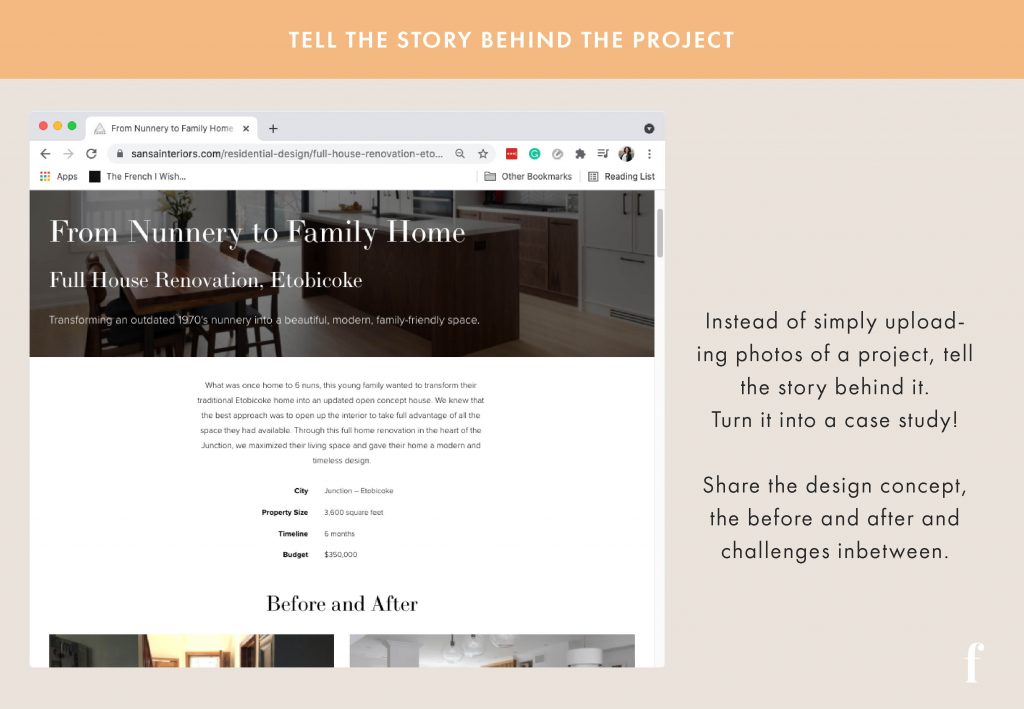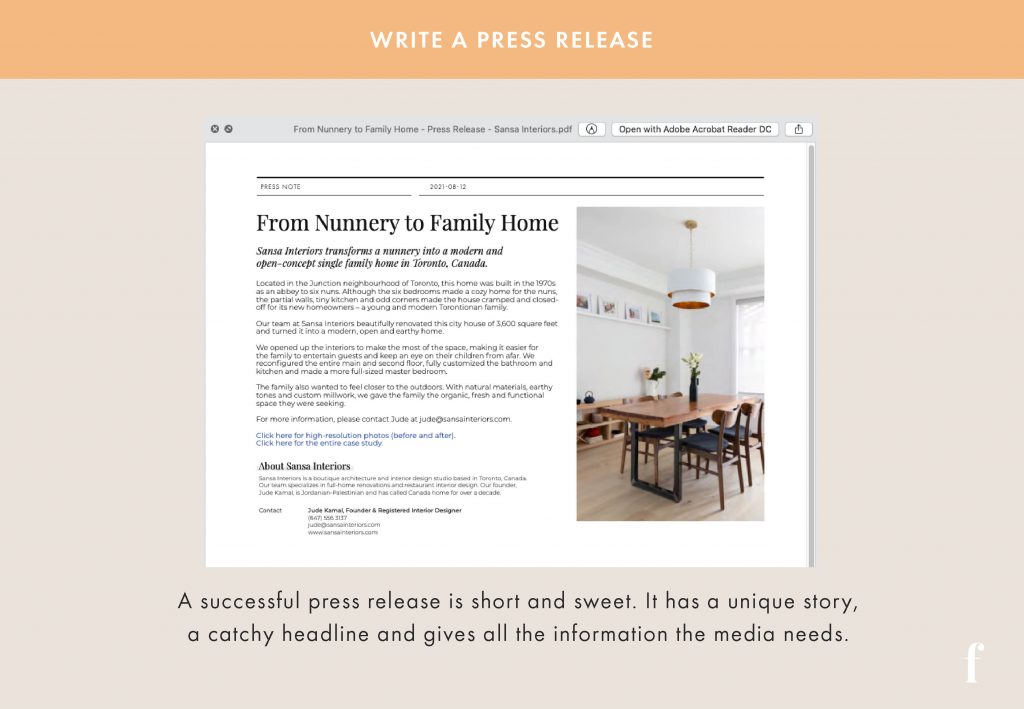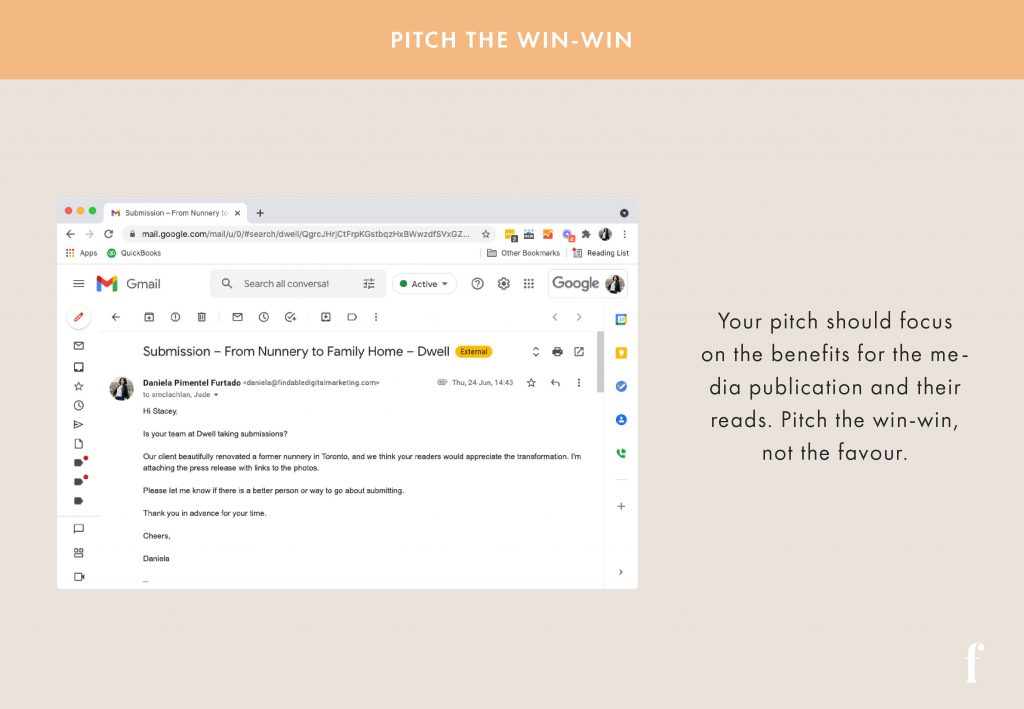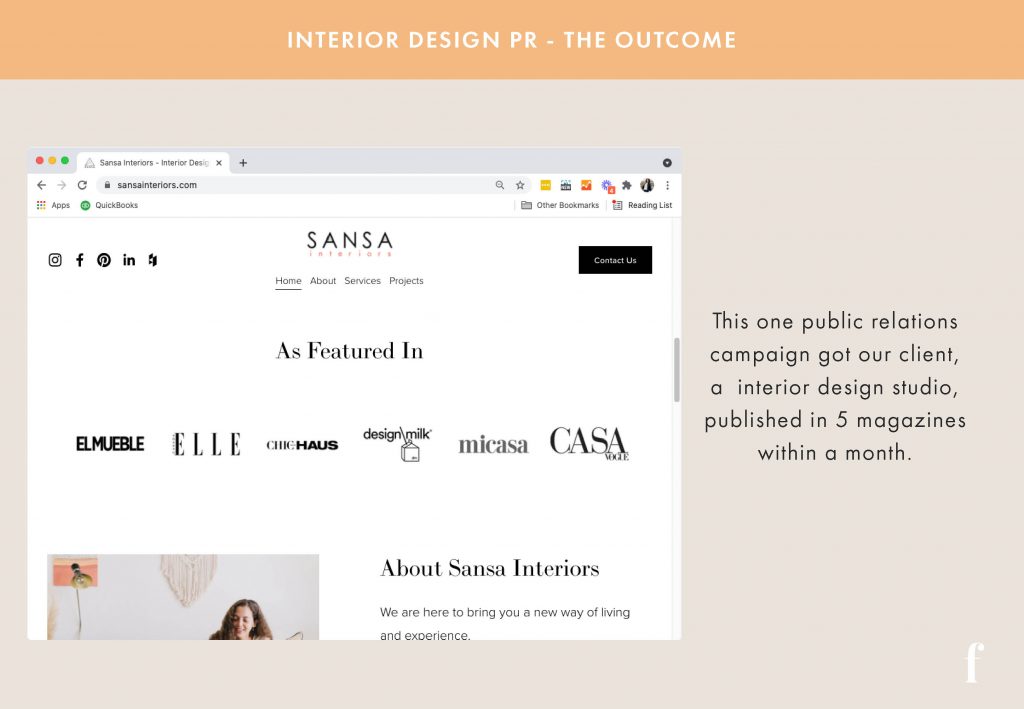We get our clients published in top design magazines like Design Milk and Home Trends. Our interior design PR process is proven to work, and this is how we do it.
Getting featured in a design magazine can make a big difference for your interior design career and could be a game-changer for your business. It can launch your interior design business to a broader audience, give you credibility and social proof, and attract new clients. Given these benefits, it’s no surprise that interior design PR is an essential aspect of any interior designer’s business and career.
With many designers clamouring for very few spots in magazines and publications, proper interior design PR can help your design work get noticed by design magazines and get you a highly converted feature.
A common misconception is that you need to have connections to get published. It helps, but no journalist or editor will be interested if you don’t have a unique story or project, even if you have a relationship with them.
Jump Ahead
Our Interior Design PR Process
Using a real interior design PR example, we’ll show you our process on how we get our clients published in interior design magazines using one specific client as a case study: Sansa Interiors’ Nunnery to Family Home Project.
1. Have a Unique Story
To get your work noticed, you have to pitch a unique story that will pique the interest of publishers and editors. Do not just pick any project at random to pitch to design magazines. Pick a project that has a unique story behind it. Ask yourself: does your story have an interesting backstory that can evoke emotions or create a human connection with readers?
For example, maybe the building or neighbourhood has an interesting history, the homeowners (your clients) have a unique backstory about the house, or perhaps the designing process has an interesting arc worth sharing.
Having a unique story sets your project apart. Storytelling is a powerful tool, and you can use it to your advantage.
For example, having a unique backstory was a game-changer in our client, Sansa Interiors. Initially, the client called the project “Family Home in High Park.” Though this was a nice name for the project, it didn’t stand out. After speaking with the design team, we learned that the home was a former nunnery. Voila! We found something special about the project, a unique angle, and we came up with the catchy headline: From Nunnery to Family Home.
To find a unique story or angle in your project, keep these two rules in mind:
- Do not bury the lead. Ask yourself, “what is the most remarkable and unique aspect of this project?” Yes, your designs and skills are remarkable. However, to get that noticed, you must use the power of storytelling. Find your unique story and lead with it.
- Add a personal touch. In the case of Sansa Interiors, the former nunnery project adds a personal touch to the story. Readers can immediately tell that nuns used to live there, which awakens their imaginations and draws them in. Think of how you can add a personal story to your design projects. You could even include the homeowners’ personal stories if they are willing.
2. Tell the Story Behind the Photos
A common mistake we see designers make is that they slab the photos on their websites with little or no description text to accompany the images. So you can’t tell what they did to the space. Did they tear down the walls or add pillows?
Without an accurate description, the pictures have no context, so whoever views them has no idea what the designer did.
Secondly, by adding the proper description to your photos, you make it easy for journalists to write about your project by giving them everything they need upfront. This is an important point for interior design PR that can set you apart from the rest: high-resolution photos with proper descriptions.
With Sansa Interiors, not only did we add proper descriptions to the photos of the nunnery project, but we also turned it into a case study. We described the photos using a storytelling narrative to keep readers engaged.

This storytelling tactic creates a natural flow with the pictures that take readers on a journey through your project from start to finish. We also made sure the case study was SEO-friendly. We optimized for keywords like “home renovation Etobicoke” so that the case study would attract traffic from Google.
3. Choose the Magazines Carefully
The first step in creating a press release is to choose the magazine correctly.
Don’t just pitch to any and every design magazine out there. Choose magazines that
- have a similar aesthetic to your project and
- have an audience that would appreciate your project.
It plays to your advantage when you choose magazines that match your aesthetic. A match of aesthetics means that the magazines will be happy to publish your project photos as they fit what they usually look for. We will show you a great example of this later in this article when we discuss outcomes. In other words, choose relevant magazines.
Keep in mind that some magazines prefer exclusivity, especially if it will be published in a print edition. So if your project hasn’t been published yet, then mention that in your press release. It’s important to note that if you are pitching to print magazines, you have to pitch exclusive projects in order to get a shot at being published.
4. Write a Press Release
Writing a press release is one of the most critical aspects of interior design PR. By creating a press release, you can bring immediate exposure to your project.
Journalists and editors receive cold pitches all the time, many of which they ignore. However, they are trained to look out for press releases because it is a vital tool in their industry.
Another great advantage of a press release is that when you create a proper one, you make the journalist’s work easier. They can quickly formulate a piece from your press release or even, in most cases, publish parts of your press release.
A press release also gives you proper control of your narrative. As explained in the previous point, you make sure you include a proper description of your project and your choice of keywords in your press release.

For Sansa Interiors, we turned their nunnery project into a case study and then turned the case study into a press release. Our press release included links to the case study as well as high-resolution images.
5. Pitch the Win-Win
It’s not just about what they can do for you but what your project can do for them.
When you send your pitch email and/or press release, make your pitch short and sweet so that it highlights a win for the magazine. Frame your pitch in a way that says, “this story is great for you and your readers” instead of “please do me a favour and publish me.”
As you can see from the screenshot of our pitch email below, we made sure to focus on the benefits of our project to their audience. So instead of making a statement like “we will really appreciate it if we are featured,” we wrote, “your readers will appreciate this transformation”. This communicates a win-win situation.

6. Don’t Forget to Follow-up
Follow-up is key. People are busy, and follow-up helps remind them about you and keeps you fresh in their memory and inbox. Often, you would not get a response the first time. A well-crafted follow-up email gives you another shot to pique their interest.
Remember, interior design PR is like sales, except you are selling your brand and your projects. Follow-up is crucial for sales, and according to a study done by Yesware, it takes an average of 5 follow-up emails to close a sale.
Make sure you apply tact when sending follow-up emails. Do not bombard journalists with email after email because that could get you the opposite desired effect. Instead, make sure to communicate that you’re appreciative of their time and understand their busy schedule.
7. Build Relationships
When pitching your projects to design magazines, you will hear “no” a lot. But receiving a “no” from a design magazine does not have to be the end. Interior design PR requires persistence and patience. Sometimes a no means “not right now” or “not this project.”
When you get turned down, thank them for taking the time to respond to you and leave an open line of communication. Try to maintain a relationship with the editors and be kind and genuine, and they’ll remember you. The next time you have to pitch a project to them, it will feel less like a cold pitch as they are more familiar with you.
8. Have a Professional Website
A professional website is the billboard of your interior design business. Make sure you have a professionally made website that showcases your work with high-quality images. Design magazines only want to be affiliated with trustworthy brands and designers. If they are interested in your pitch or press release, the first thing they do is to check your website and sometimes your social media pages. A professionally done website gives you credibility and puts you in good light both for the journalists you are pitching to and their audience (who include your potential clients) when you get published.
The Outcome
We pitched the Sansa Interiors’ nunnery project to 25 interior design magazines around the world. After applying all the steps on how to get published in interior design magazines that we listed above, we got the nunnery project published in five magazines to date – four online and one in print.
We got published and featured in these six magazines
- Design Milk, USA
- Home Trends, Canada
- Casa Vogue, Brazil
- El Muble, Spain
- Micasa, Spain
- Chic Haus, Mexico
These three magazines have it in their editorial lineup for galleries.
- Design Lines, USA
- Toronto Life, Canada
- House & Home, USA
These features will mean an estimated 5 million views, which is excellent exposure for our client Sansa Interiors and a win for us.
As you can see from the results we got, getting published in design magazines can be done. You might see it as a big and almost impossible goal, but you can achieve it with the right knowledge and by following the right steps or with the right help.

The Value of PR for Interior Designers
Recognition
Getting published in design magazines will give you lots of recognition and expose your work to a broader audience by both your peers in the industry and potential customers.
One of our PR wins for Sansa Interiors is that the Nunnery project got published on the Design Milk’s Instagram page (one of the five publications Sansa Interiors has already been featured in).
Design Milk has 3.8 million followers, and the feature brought a ton of exposure and many new followers for the Sansa Interiors Instagram page. You can get great recognition like that with good interior design PR.
Another point to know is that Design Milk was a strategic choice in choosing magazines to pitch to because we knew our project photos would blend seamlessly with their aesthetic, and it paid off! They published our pictures on their highly curated Instagram page.
Search Engine Optimization (SEO)
The links that come from press features help with your SEO. Google’s algorithm puts high importance on backlinks. More press means more backlinks, and more backlinks mean you have a higher chance of ranking on the first page for keywords that will bring you traffic and sales.
How to Get Published In Interior Design Magazines
We’ve shown you important points on how to get published in interior design magazines, and we used our case study of working with Sansa Interiors to show you that it can be done. Our way is proven and tested. Below we summarize the key takeaway points.
Summary and Key Takeaway Points from Interior Design PR Process
- Have a unique story. Pick a unique angle to your projects and use the power of storytelling to make you stand out and be memorable.
- Use proper photo descriptions. Tell the story behind the pictures to provide adequate context and help people better understand your work. And make sure your images are professionally taken.
- Be strategic about the choice of publication or magazine. Match your project to the magazine and make your aesthetics align.
- Write your pitch and press release carefully. Make your pitch and press release concise and professionally written.
- Temper exclusivity with caution. We mentioned that some print magazines prefer exclusive projects that haven’t been published anywhere. However, many publications do not care if it’s not exclusive to them. While it’s great to be on a print publication, make sure this exclusivity is not preventing you from sharing your work with the world. It might be better to pitch to several publications. Like with Sansa Interiors, we pitched to 25 and got published in five so far.
- Build relationships. Stay in touch even if they say no. Sometimes a no means “not right now” or “not this project.” Say thank you when you get turned down, and leave open a line of communication so you can pitch feature projects.
- Have a professional website. Design magazines want to be affiliated with trustworthy brands and designers. Your website is the face of your business on the web.
Looking for more SEO tips? We’ve got you covered – we’ve also written 13 SEO tips for interior designers.




